Horse fire
Crown fires in clean oak forests are possible in early spring and late autumn. Crown fires are the most dangerous for both forests and people; they are usually accompanied by the death of trees of all species with thin bark, a low crown and a shallow root system. A crown fire is a relatively rare phenomenon. Most of these fires develop in inaccessible mountain forests. The only practical way to deal with them is annealing. Its effectiveness is based on the fact that a crown fire cannot spread if the crown is not heated by a ground fire. At night, crown fires in the crowns almost always stop. Raised fires can be fugitive and stable; in the latter case, the fire moves as a solid wall from the ground cover to the crowns of trees at a speed of up to 8 km/hour. Runaway fires occur only in strong winds; the fire spreads along the canopy in spurts at a speed of up to 25 km/h and usually outstrips the front of the ground fire. Raised fires, releasing a large amount of heat, cause upward flows of combustion products and heated air and form convective columns with a diameter of several hundred meters. Their forward movement coincides with the direction of movement of the fire front. The flame in the middle of the column can rise to a height of 100 - 120 meters. The convective column increases the air flow into the fire zone and generates wind, which intensifies the combustion. Crown fires, releasing a large amount of heat, cause upward flows of combustion products and heated air and form convective columns with a diameter of several hundred meters. Their forward movement coincides with the direction of movement of the fire front. The flame in the middle of the column can rise to a height of 100 - 120 meters. The convective column increases the air flow into the fire zone and generates wind, which intensifies the combustion. Raised fires can be fugitive and stable; in the latter case, the fire moves as a solid wall from the ground cover to the crowns of trees at a speed of up to 8 km/hour. A sustained crown fire usually occurs in calm conditions and in light winds. It does not have a clearly defined front, and therefore it should be annealed from all sides. However, taking into account that the fire can take on a running nature, the annealed strip is, if possible, increased to 100 m, using stepped or advanced fire to speed up the annealing. All crown fires occur during the daytime. They spread in young coniferous (pine, cedar, spruce, fir) trees, as well as in older plantations with vertically closed crowns, which is formed due to the uneven age of the planting and undergrowth. Therefore, a crown fire may not form immediately, but some time after the bomb falls. This means that we must use this interval as much as possible to fight fires. More than once, crown fires have caused the death of entire cities and are one of the frequent causes of death of people caught in the forest, and often the death of workers taking part in extinguishing the fire. Extinguishing a forest crown fire is more difficult. During crown fires, a large amount of heat is released, the height of the flame rises by 100 m or more. Large crown fires are accompanied by intense movement of flame over considerable distances (sometimes up to several kilometers) with the formation of vortices. In cedar forests, crown fires can occur throughout the fire season. To extinguish overhead fires, two main methods are used: the method of cutting an explosive clearing and the counter-fire method. When extinguishing crown fires, more often than when eliminating other types of fire in the forest, it is necessary to rebuild work on the fly. Differences between forest pine forests and spruce dens and forest development after fires. When a crown fire occurs in spruce and spruce-fir forests, the barrier role of the streams themselves is significantly reduced. In such cases, fire can sometimes spread across rivers several tens or even hundreds of meters wide. In turn, ground and crown fires can be stable and fugitive. During a fluent crown fire, the shape of the square is elongated in the direction of the wind. The smoke from the crown fire is dark. The shape of the square during a fluent crown fire is elongated in the direction of the wind. The smoke from the crown fire is dark. In the same way, a crown fire is divided: a crown fire - a runaway one, in which the tops of trees are scorched and the trunks in the upper part are burned, and a stable crown fire (widespread), in which, according to the instructions of prof. Based on the speed of fire spread, ground and crown fires are divided into stable and fugitive. A weak ground fire spreads at a speed of no more than 1 m/min, a medium one - from 1 to 3, a strong one - over 3 m/min. A crown fire has a much higher speed: a weak crown fire is up to 3 m/min, a medium fire is up to 100, a strong fire is over 100 m/min. Since the intensity of combustion depends on the state of the supply of combustible materials, the degree of their flammability, the slope of the terrain, the time of day and especially the strength of the wind, during the same fire the speed of fire spread in a forest area can vary significantly. In turn, ground and crown fires can be stable and fugitive. During the period of exceptional development of crown fires, when the fight against fire can drag on for a week, it is necessary to carefully ensure that the workers do not become exhausted. Alternating work and rest brings significantly more benefits than prolonged exertion without rest. The completeness of the forest stand affects the rate of crown fire differently than that of ground fire: in closed forest stands, crown fire proceeds as a continuous fire air flow; in sparse forest stands its progress (if we exclude a storm wind or hurricane) is hampered and slowed down. Despite the relatively small number of crown fires, they spread over a large area and cause great harm. The most important characteristics are the speed of spread of ground and crown fires and the depth of underground burning. Therefore, they are divided into weak, medium and strong. Based on the speed of fire spread, ground and top fires are divided into stable and fugitive. The speed of spread of a weak ground fire does not exceed 1 m/min, a medium one - from 1 to 3 m/min, a strong one - over 3 m/min. A weak crown fire has a speed of up to 3 m/min, a medium one - up to 100 m/min, a strong one - over 100 m/min. According to the very course of the fire in crown fires, as experience shows, it is often more advantageous to shift the center of gravity of the fight to the night hours, when the wind speed decreases and the relative air humidity rises. At night the heat subsides and it is easier to work. This is why counter fire is usually only used at night. Daytime, especially the midday hours, are set aside for rest. When fire spreads to the crowns of plantings, crown fires occur. A ground fire, penetrating into dried peat, causes combustion of it or the humus layer. At the same time, the fire engulfs root system trees that fall out of the soil. This type of fire, developing in a layer of peat or humus, is called soil, or underground. That is why the leader of the work on extinguishing overhead fires requires not only Suvorov’s eye, speed and pressure, but also self-control, great endurance for the most intense work, often for entire weeks. Energistically introduce the use of chemicals in the fight against crown fires, and not just with ground-level fires, the elimination of which is much easier. In riverine and tame spruce forests, the danger of crown fires cannot be excluded due to the transfer of fire from neighboring forest types occupying elevated, drier places; the risk of crown fires is higher the more fir and cedar there are in the forest stand, and the lower the more; deciduous: alder, birch, aspen, etc. To what was previously said regarding fir (the role of essential oils, witches' broom, etc. The proximity of conifers, especially young pine trees, creates a threat of crown fire, and two can be distinguished possible options : 1) less dangerous - when young pine trees adjoin old pine trees, but do not enter under their canopy and 2) more dangerous - when such young stands not only adjoin, but even enter under the sparse canopy, increasing the threat of the crowns and old trees catching fire. From them, the fire is transferred to the crowns of neighboring, more closed stands, and thus a crown fire is formed. We have often observed crown fires in the forests of the north with just this combination. The organization of work and the correct balance of forces acquire special importance when extinguishing crown fires, not only because of the dangers that threaten the forestry object - the forest, but also due to the serious danger for people working to extinguish such fires. When developing new effective technical means of extinguishing grassland, peat and especially crown fires, the use of conversion equipment and dual technologies is provided. To test new forest fire equipment, it is planned to build a special testing ground in the city of Luga, Leningrad Region. The completeness of the forest stand affects the rate of crown fire differently than that of ground fire: in closed forest stands, crown fire proceeds as a continuous fire air flow; in sparse forest stands its progress (if we exclude a storm wind or hurricane) is hampered and slowed down. In riverine and tame spruce forests, the danger of crown fires cannot be excluded due to the transfer of fire from neighboring forest types occupying elevated, drier places; the risk of crown fires is higher the more fir and cedar there are in the forest stand, and the lower the more; deciduous: alder, birch, aspen, etc. To what was previously said in relation to fir (the role of essential oils, witches' brooms, etc. But, once they occur, fires cause much more harm here, since due to the low descent of living branches and the presence of different heights of undergrowth, any ground fire in spruce and fir forests quickly turns into a crown fire. In this case, spruce forests that survived fires in logs with moist soil can even expand the territory they occupy. Running crown fires occur both in the first and second half of the summer . During crown fires, a large amount of heat is released, the height of the flame rises by 100 m or more. Large crown fires are accompanied by intense movement of the flame over significant distances (sometimes up to several kilometers) with the formation of vortices. Forest fires are divided into ground fires, crown fires and underground, or peat fires . Among crown fires it is necessary to distinguish: 1) crown fires, 2) general fires, 3 trunk fires. During a fluent crown fire, the shape of the square is elongated in the direction of the wind. The smoke from the crown fire is dark. The shape of the square during a fluent crown fire is elongated in the direction of the wind. The smoke from the crown fire is dark. Forest fires - ground fires, crown fires, subsurface fires, etc. - are dangerous natural disasters that cause enormous damage and pose a threat to people located near the areas where fires occur and spread. In a crown fire, trees burn from bottom to top; In a ground fire, dry grass, moss, lichen, and shrubs burn. A top stable fire is the next stage of a bottom fire; the flame of a bottom fire sets fire to the crowns of trees, while needles, leaves, small and larger branches burn. The tree stand after a crown fire, as a rule, dies completely, leaving only the charred remains of the trunks. In a stable top fire, the fire spreads across the crowns only as the edge of the bottom fire moves. In a running fire on top, which occurs only during a strong wind, the fire spreads along the tree crowns in jumps, ahead of the front of the ground fire. The wind also carries burning branches, other small burning objects and sparks, which create new ground fires hundreds of meters ahead of the main source. In some cases, fire is spread in this manner across rivers, wide roads, treeless areas and other apparent boundaries to localize the fire. A top stable fire is the next stage of a bottom fire; the flame of a bottom fire sets fire to the crowns of trees, while needles, leaves, small and larger branches burn. The tree stand after a crown fire, as a rule, dies completely, leaving only the charred remains of the trunks. In a stable top fire, the fire spreads along the crowns as the edge of the bottom fire moves. Risk of fires in spruce forests. In conclusion, let us remind you once again that reducing the risk of fire in spruce forests does not mean reducing the risk of destruction from it in these forests. On the contrary, there is a very high threat of the most destructive crown fires. In forests Far East, Siberia, the Urals, and the north of the European part of Russia, they patrol forests from airplanes and helicopters. In addition to detecting fires, aviation is widely used in extinguishing ground and crown fires. In Russia, more than 519.96 million hectares of forest are protected from the air. For this purpose, a network of air bases with operational air departments has been organized. The forest area protected by land-based methods is approximately 80 million hectares. The increased rate of crown fires, especially crown fires, is facilitated by the presence of ethereal and resinous substances in the needles and other parts of trees. Even in deciduous forests, but consisting of species containing essential oils, crown fires develop. Eucalyptus forests are a particularly striking example. Runaway ground fires are characterized by rapid fire progression, as dry grass and fallen leaves burn. In this case, as a rule, mature trees are not damaged, but there is a threat of a crown fire. With stable ground fires, typical of the second half of summer, the edge of the fire has a relatively low speed of advancement, but a lot of smoke is produced.
The following classification of fires has been developed for forestry
- Riding (weak, medium, strong)
- Grassroots (weak, medium, strong)
- Underground and litter (weak, medium, strong)
Forest fires can be runaway (at high wind speeds) and persistent.
Separately, it is worth considering grass fires (agricultural fires)
Horse fire
During a crown fire, the crowns of trees burn. Crown fires, like ground fires, are divided into runaways And sustainable. At fluently in a crown fire, the fire quickly spreads along the tree crowns in the direction of the wind, and when sustainable(widespread) - fire spreads throughout the entire tree stand: from the litter to the crowns. Burning individual trees and curtains. The emergence and development of crown fires occurs from the transition of fire from ground fires to the crowns of coniferous stands with low branches, in multi-tiered plantations with abundant undergrowth, young forests, as well as in mountain forests. Speed of crown fires: sustainable - 300…1500 m/h (5…25 m/min), runaway - 4500 m/h or more (75 m/min or more).
The most susceptible to crown fires are young coniferous forests, thickets of dwarf cedar and shrubby oak (in the spring in the presence of dry leaves from last year), in mountain forests - all coniferous plantations in the upper part of steep slopes (more than 25o) and on passes. Droughts and strong winds greatly contribute to the occurrence of crown fires.
ground fire
Ground fire
During a ground fire, forest litter burns, consisting of small branches, bark, pine needles, and leaves; forest litter, dry grass; living ground cover of grasses, mosses, small undergrowth and bark in the lower part of tree trunks.
Based on the speed of fire spread and the nature of combustion, ground fires are characterized as runaways And sustainable.
Fluent A ground fire develops most often in the spring, when only the topmost layer of small combustible materials of the ground cover and last year's herbaceous vegetation dry out. The speed of fire spread is quite significant - 180...300 m/h (3...5 m/min) and is directly dependent on the wind speed in the ground layer. Forest litter burns by 2...3 cm. At the same time, areas with high humidity the ground cover remains untouched by fire and the area covered by the rapid fire has a spotted shape.
Stable A ground fire is characterized by complete combustion of the ground cover and forest litter. Sustainable ground fires develop in mid-summer, when the litter dries out throughout the entire thickness of the bed. In areas traversed by a sustained fire, the forest floor, undergrowth and undergrowth are completely burned. The roots and bark of trees burn, resulting in serious damage to the planting, and some trees stop growing and die. The speed of fire spread during a stable ground fire is from several meters per hour to 180 m/h (1...3 m/min). Based on the height of the flame burning edge, ground fires are characterized as weak (flame height up to 0.5 m), medium (flame height up to 1.5 m) and strong (flame height more than 1.5 m).
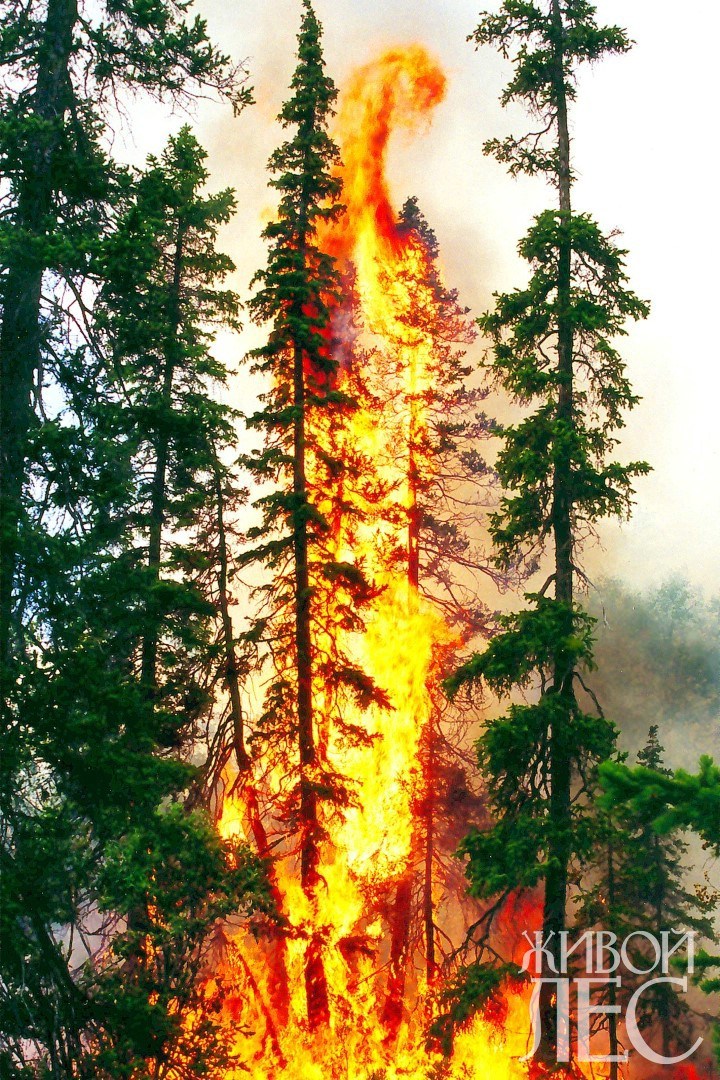
grass fire
Grass fires (agricultural fires)
Separately, it is worth considering grass fires (agricultural fires) - the burning of dry grass on agricultural land, meadows and pastures, in river valleys. Typically grass fires occur in the spring. Grass burning burns last year's dry grass and stubble left in the field. The speed of fire spread depends on wind speed.
In a severe fire, the fire moves quickly and fluently. Often in moist areas, part of the grass remains untouched by fire, and individual clumps remain unburnt. In weak winds, the speed of propagation is much lower. In this case, all dry grass burns out.
The flame height ranges from a few centimeters on stubble to 1 - 1.5 m on deposits. Up to 3-5 m when reed burns.
Grass fires are the main cause of much more destructive fires in forests and peatlands.
Ground fire
A ground fire develops as a result of the “deepening” of a ground fire into the litter and peat layer of soil.
Soil fires are divided into litter-humus, in which combustion spreads throughout the entire thickness of the forest litter and humus layer, and underground or peat in which combustion spreads along the peaty horizon of the soil or peat deposit under a layer of forest soil. In such a fire, the roots burn out, the trees fall out and fall, usually with their tops towards the center of the fire. The fire in most cases has a round or oval shape. The rate of fire spread is insignificant - from several tens of centimeters to several meters per day.
Fire elements
The names of the elements of a natural fire, developed by the practice of forest fire work, are shown in the figure. A unified approach to the names of individual elements of a fire will ensure mutual understanding when organizing its extinguishing.
|
|
Features of the occurrence and spread of forest fires
The occurrence, spread and development of forest fires depend on the terrain, vegetation, weather and other conditions. These conditions must be taken into account in order to most expediently organize firefighting and ensure the safety of forest firefighters and other persons taking part in firefighting.
The forest has an abundance of combustible materials and air oxygen. A source of high temperature (fire) that can cause combustion comes from outside. It's left unattended and divorced outside designated place a fire, a burning cigarette butt or match, sparks from the exhaust pipes of various mechanisms, burning of last year's vegetation and flammable rubbish, other sources of fire associated with human activity, and lightning strikes.
The combustion process sequentially goes through the following phases:
preheating and drying with the release of water vapor (120 °C);
drying, burning with the release of water vapor, flammable substances (acids, resins) - 260 °C;
ignition of gases (315...425 oC): flaming combustion with smoke release, carbon dioxide, water vapor and unburned gases (650...1095 °C);
charring and burning of coals until complete combustion of combustible materials.
During the combustion process, a large amount of heat is released, which enters environment by:
convection - propagation high temperatures by raising a mass of hot air above the combustion site in the form of a convection column;
radiation - the spread of high temperatures in the form of radiant energy along a radius in all directions from the combustion source;
conductivity - the spread of high temperatures through combustible materials from the source of combustion.
In addition to the heat generated, there are many factors that determine the further behavior of the fire, but the main ones that have a decisive influence on the spread of the fire are flammable material, weather conditions and terrain.
Forest combustible materials
According to ignition conditions, forest combustible materials (FCM) can be divided into two main groups:
flammable and fast-burning materials - dry grass, dead leaves, pine needles, small branches, twigs, some shrubs, self-seeding, etc. These combustible materials ensure the rapid spread of fire and serve as igniters for slow-flammable materials;
slowly flammable forest combustible materials - dead wood, stumps, lower layers of forest litter, bushes and trees. This group of flammable materials, when burned, releases a large amount of heat and contributes to the development of a fire.
Weather conditions
Air temperature when extinguishing fires is one of the main factors. It is known that the higher the temperature, the faster the flammable material dries. The temperature of the soil surface also affects the movement of air currents. Air temperature directly affects firefighters, making their work more difficult.
Wind. Under the influence of wind, combustible materials dry out, and the rate of spread of combustion increases, especially in crown forest fires. This contributes to the emergence of new combustion sources by transporting burning particles. A forest fire causes local air currents to occur, which increases the influence of the prevailing wind on the spread of fire. The air above the surface of the flame heats up and rises. Fresh air rushes in its place, which promotes the combustion process. As a result, a convection (heat) column is formed above the fire. The convection column often contains burning branches, bunches of pine needles, which rise above the forest canopy, and then fall into the forest at a distance of 200...300 m or more from the main source of combustion (depending on the wind speed and the slope of the convection column) and create new sources combustion.
Air humidity.
There is always moisture in the air in the form of water vapor. The amount of moisture contained in the air is reflected in the moisture content of combustible materials. Humidity of combustible material - important factor, affecting the progress of fire extinguishing, since raw combustible material, like most types of “green” combustible material, does not burn.
Daily cycle of forest fire development
something like this:
maximum burning intensity from 9 to 21 hours - it is very difficult to extinguish;
decrease in burning intensity from 21:00 to 4:00 - extinguishing efficiency increases;
low burning intensity from 4 to 6 hours (mostly flameless burning) - the best extinguishing time;
increase in burning intensity from 6 to 9 hours - good time for stewing.
Cooler night temperatures, moisture absorption by combustible material, reduced winds and other elements of nighttime weather usually make the job easier for firefighters. Therefore, the optimal time for localizing and extinguishing fires should be taken into account
The terrain, especially mountainous, has a unique influence on the spread of fires.
During the day, as the sun heats the earth's surface, the layers of air near the ground heat up and rise. So during the day air currents usually “flow” up hollows and slopes. In the evening and at night, the surface of the earth cools, air currents change their direction and flow down the hollows and slopes. As for wind flows, they are connected by the same pattern: during the day the wind blows up the slope, at night - down the slope. This is important to remember when planning to fight a fire.
IN mountain conditions The direction and speed of fire spread depend on the exposure and steepness of the slopes. A fire easily spreads up a slope, and the steeper the slope, the higher the speed of movement, unless the wind has the strength to change this situation. Thus, with a slope of 5°, the speed of fire edge propagation increases by 1.2 times, at 10° - by 1.6 times, at 15° - by 2.1, at 20° - by 2.9, and with a slope steepness of 25°, the speed of fire edge propagation increases by 4.1 times.
When climbing up a slope, the fire is located at a small distance from the lower part of the tree crowns. This causes them to heat up, dry out and ignite faster. Warm air rises up the slope and causes “draft”, resulting in an increase in the speed of fire spread.
At the same time, on steep slopes, burning materials can roll down and create new sources of combustion.
Forest fires are a real disaster; they cause considerable harm to both nature and people. However, oddly enough, fire can have a positive effect on vegetation. Let's figure out when a forest fire becomes our enemy and when it becomes our friend.
Uncontrolled distribution
Fedor Nikitin
A forest fire is usually understood as the spontaneous, uncontrolled spread of fire across a forest area.
In general, fires cause enormous damage to forestry and the country’s economy: wood burns, tree growth decreases, and the composition of plantings and their sanitary condition deteriorate. Fires consume oxygen and release carbon dioxide into the atmosphere. carbon monoxide, enhance the greenhouse effect.
More than 95% of fires occur due to human fault, and not as a result of deliberate arson, but due to non-compliance with basic rules fire safety. In the forests of the Moscow region, the situation is complicated by the frequent burning of agricultural land bordering forests. After the collapse of state farms, most of the agricultural land is not cultivated and is overgrown with weeds, which, when drying out, form flammable material in spring and autumn. Fire spreads across fields at high speed and often spreads into forests.
There are three types of forest fires: ground fires, crown fires and underground fires.
Ground fires
Ground forest fires most often occur, which, based on the speed of fire spread and the nature of combustion, are usually divided into fugitive and stable.
Runaway ground fires usually occur in spring in grass-type forests, when the top layer of litter and last year's grass dry out. In such a fire, the fire spreads at a speed of 3 – 5 m/min, damaging young growth, undergrowth, shrubs and other plants of the lower tiers. Tree stands suffer little damage during ground fires. Significant damage is caused to animals, birds and insects.
Sustained ground fires characteristic of green moss forest types, in which green mosses, blueberries, lingonberries and sorrel grow. In such forests, conifers predominate; a layer of litter up to 15 cm is formed on the soil from fallen needles, cones, small branches, bark, and leaves.
During dry summers, the litter dries out to its full depth and becomes flammable. In such conditions, stable ground fires develop, the speed of their spread is much lower, 1 – 3 m/min, and they can last for several days.
For example, under the crowns of centuries-old fir trees, the smoldering litter completely burns out in 2 – 3 days, which damages the roots and bark of trees. As a result, tree species with shallow root systems and thin bark, such as spruce, die. In pine and larch forests, up to 30% of trees dry out, the rest weaken. Plantations damaged by fires often become hotbeds of development dangerous pests and diseases. Sustained ground fires completely destroy herbaceous vegetation, undergrowth, undergrowth, partially soil humus, and seeds located in the litter and upper layers of soil. Animals, birds and insects suffer to a greater extent than in a runaway fire.
IN forestry To destroy logging residues, fire cleaning of cutting areas has long been used, in which the spread of fire is controlled by humans. There is no consensus among domestic and foreign scientists regarding fire cleaning of cutting areas.
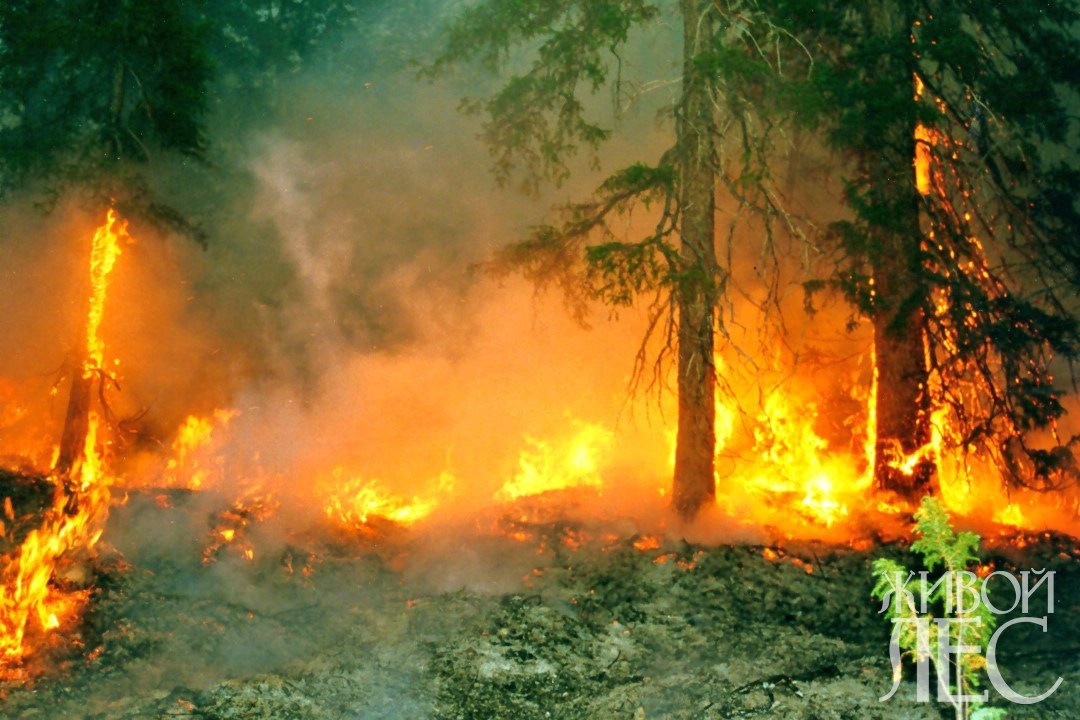 forest fire
forest fire 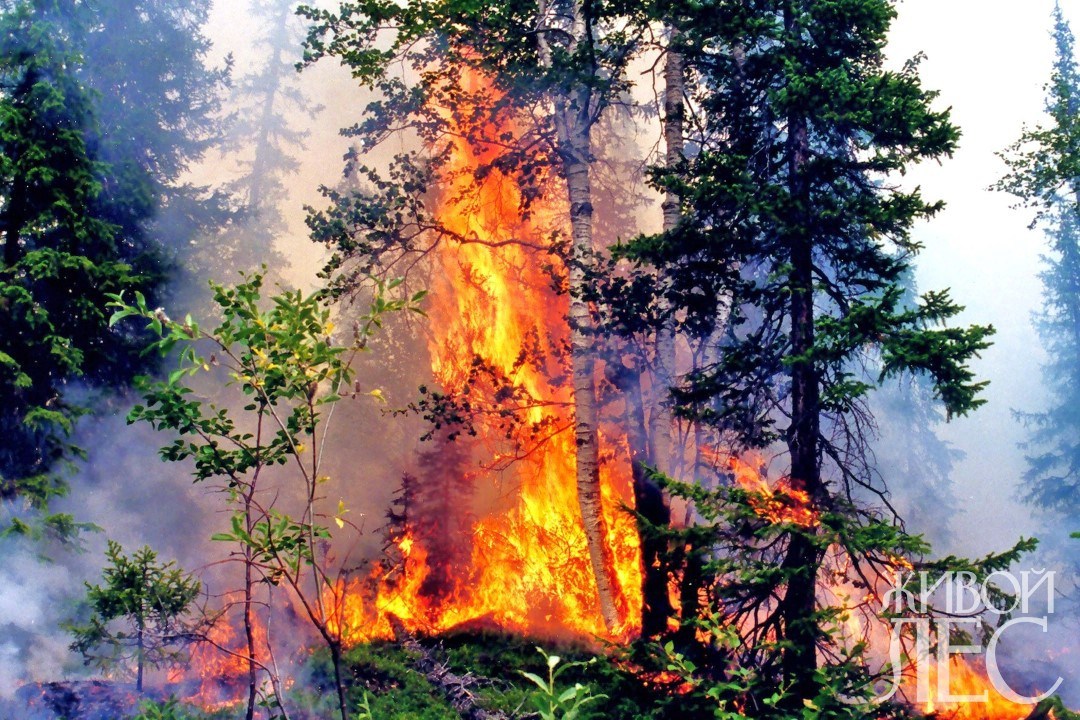
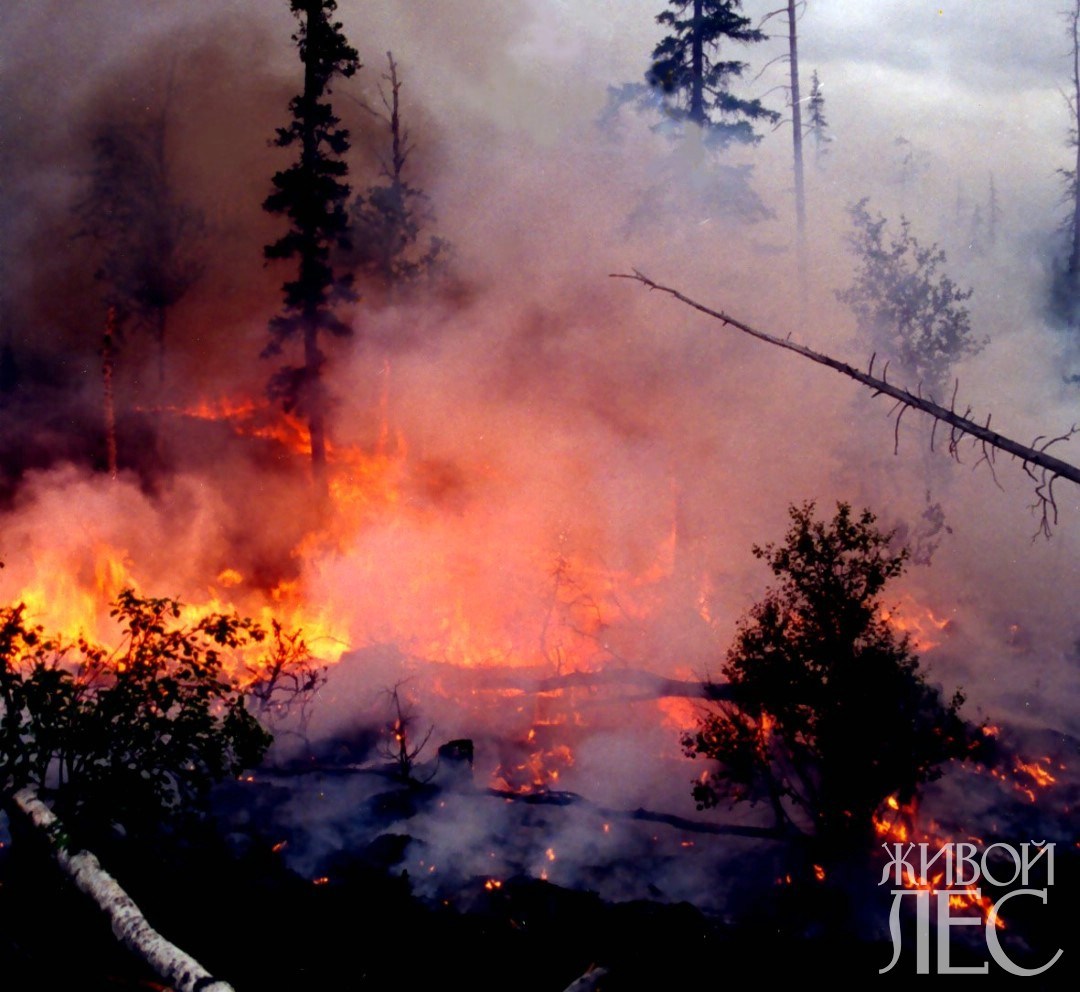
Positive value:
- improving the sanitary condition of the felling area;
- reducing the risk of fires after burning the bulk of organic matter;
- improvement of conditions for natural regeneration of tree species.
Negative Impact:
- large losses of fixed nitrogen, as a result of which the nitrogen balance of the soil is disturbed, and this leads to a deterioration in its physical properties;
- destruction of undergrowth, seeds of trees and shrubs, beneficial representatives of insects and microorganisms.
 Horse fires
Horse fires
During crown fires, the fire covers not only the ground cover and litter, but also the crowns of trees. The propagation speed can reach 350 m/min. Such fires occur in dry weather with strong winds, most often in coniferous plantations. Due to their low-lying crowns, young coniferous trees can burn even in low winds. Crown fires have a large destructive force, they lead to the complete destruction of forest stands and all components of forest biocenoses. The fire destroys buildings, power lines, and people often die in the fire.
Forest-peat or underground
Forest-peat or underground fires occur primarily on drained forest lands. After peat fires forest areas turn into rubble from burnt forest, deep soil failures. Reconstruction of such lands is very labor-intensive, and they are usually excluded from forestry use for several decades. Peat fires are difficult to extinguish and continue to burn even after heavy downpours. Forest fires lead to long-term smoke in large areas, serious disruptions to air and ground transport, numerous accidents with tragic consequences, and harm human health.
Currently, with the adoption of the new Forest Code of the Russian Federation, most of the forest lands are given for long-term lease. To reduce fire danger it is necessary to develop a system of measures and standards for the targeted formation of fire-resistant plantings on leased forest lands and oblige forest owners to comply with these requirements. With this approach, it is possible to achieve effective control over the forest fire situation.
When fire is beneficial
Sergey Shkarinov, Candidate of Agricultural Sciences
Over the past year and a half alone, the whole world has repeatedly followed the heroic fight against forest fires in Australia, Portugal, Spain, Greece and California. And in all cases, the person ended up losing in this struggle. However, fire is not only a destructive element, but also a natural phenomenon, with whose direct participation the Earth’s biosphere was formed and the evolution of living organisms took place.
Pyrogenic species
Life higher plants, from the very first primitive ancestral forms to all the diversity modern species, occurs against the background of two processes - photosynthesis (the creation of organic matter) and combustion (its destruction during combustion). IN different parts Around the globe, plant communities were periodically destroyed by fire. This impact predetermined the emergence of adaptive adaptations in plants aimed at restoring plant communities to replace those destroyed by fire. This is how pyrogenic species arose, the reproduction of which is possible only in burnt areas - territories liberated by fire from the vegetation that previously existed on them.
A classic example of pyrogenic plants is eucalyptus - evergreen trees and shrubs of more than 500 species that grow in Australia and its surrounding islands. Characteristic feature species that form eucalyptus forests in dry climates are specific feature their seeds, which cannot germinate without exposure to high temperatures. Thus, seed regeneration of these species is possible only after forest fires.
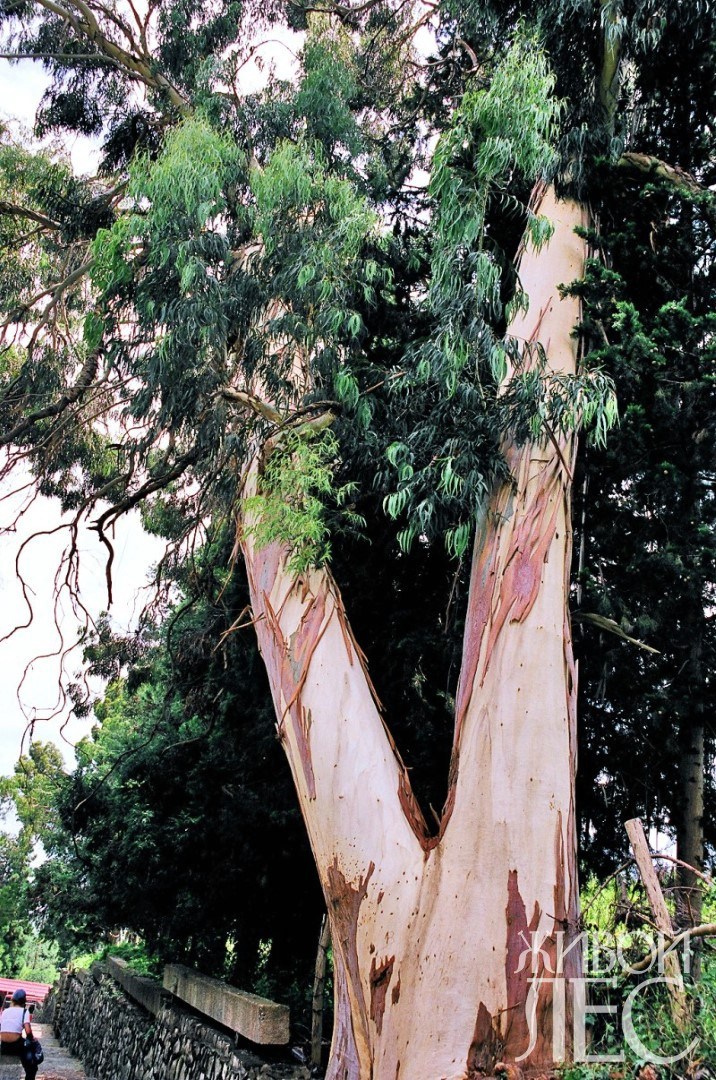
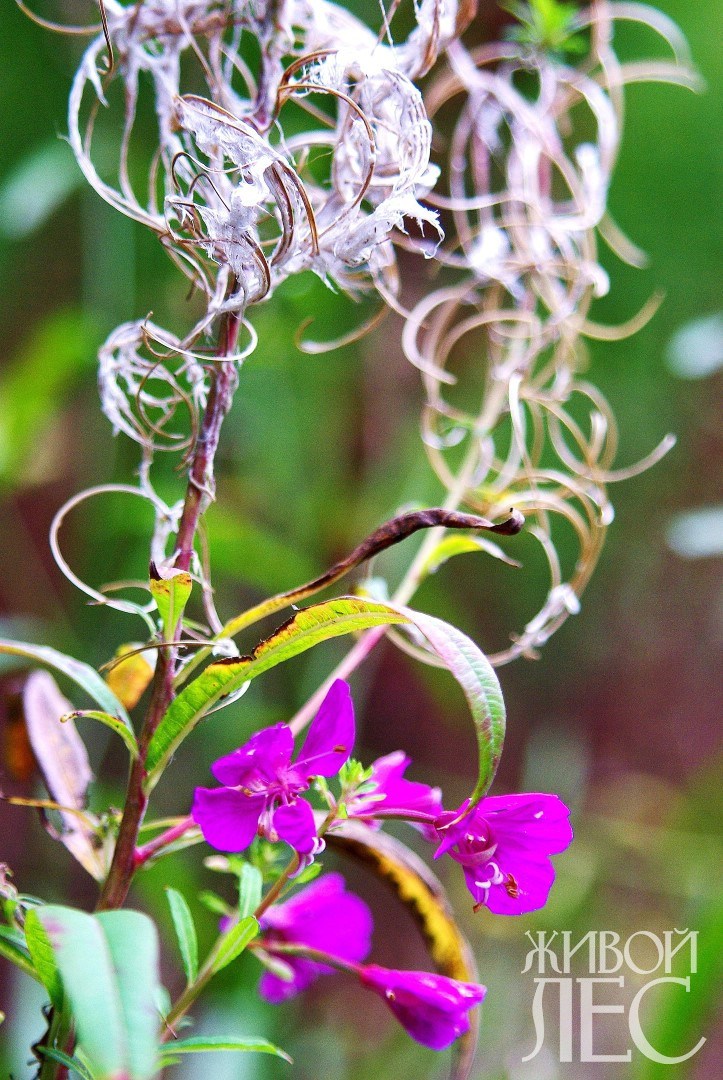
Almost all light-coniferous - larch and pine virgin forests of the taiga zone are of pyrogenic origin, i.e. they formed on forest burnt areas. The most important biological feature of Scots pine and all types of larch is its love for light. These species did not develop evolutionary adaptations that would allow them to regenerate under the forest canopy, and there was no need for them - forest fires regularly prepared territories for their successful seeding. However, it is not always the case that light-coniferous tree species are immediately successfully restored in burnt areas, and after 10–15 years, the depressing black scorched desert with protruding charred remains of trunks is replaced by dense young coniferous growths pleasing to the eye. Often, for a certain period of time, burnt areas can be colonized by herbs, among which there are also pyrogenic species.
Fireweed is a large perennial (up to 2 m tall) from the fireweed family, the biology of which is closely related to the effects of fire. The plant produces a huge number of tiny seeds with appendages in the form of fluff, which are capable of spreading over long distances and densely sowing vast areas. However, to grow into normal conditions they cannot - this is prevented by the living cover of plants covering the soil. The ideal place for mass germination of fireweed seeds is burnt areas.
With the help of fire
Man has long learned to use the power of fire on vegetation. Even our ancestors in the Middle Ages successfully used the system of fell farming. To do this, the most conveniently located areas of the forest were burned and grain and fodder cereals, as well as flax, were sown in the liberated territory. Pal created conditions that ensured high yields of these crops for several years. When the soil was depleted and yields began to decline, they moved to a new place, prepared in advance with the help of firewood. The abandoned areas gradually became overgrown with forest again. Almost all forests located near populated areas grew on lands that were previously cultivated with firewood.
The positive effects of fire have also been successfully used in forestry practice. The famous German forester Karl Francievich Thürmer considered natural regeneration to be appropriate only in a very limited number of cases and was a strong supporter of forest planting. However, few people pay attention to one technological feature which he used. Seedlings were always planted in ash beds. Thus, the best man-made forests in Russia were created using fire at the stage prior to planting. In forest clearings, after burning the logging residues, ash ridges formed, which served as an ideal place for planted seedlings.
When using this technology, several goals are achieved at once, ensuring unhindered growth and harmonious development of plants. Firstly, the area is disinfected, during which the pests and pathogens that existed in the felled forest and remain in the soil and logging residues are destroyed; secondly, competition from outside is temporarily eliminated herbaceous plants and natural regeneration of small-leaved tree species and shrubs. Grown by K.F. In terms of productivity and other important taxation indicators, forests are several times superior to their natural counterparts.
Talking about some positive aspects impact of fire on vegetation, we must not forget about the negative role of the fire element. The main culprit of vegetation fires in modern world is a person. In Russia, fires most often occur in the spring, during the spring drought, and in the summer, during the hottest season.
Who is to blame and what to do?
Speaking about some of the positive aspects of the impact of fire on vegetation, we must not forget about the negative role of the fire element. Before man learned to make fire, the most realistic factor causing plant fires was thunderstorms, and fires caused by lightning were relatively rare, because a thunderstorm is usually accompanied by rain, which prevents the spread of fire.
The main culprit of plant fires in the modern world is man. In Russia, fires most often occur in the spring, during the spring drought, and in the summer, during the hottest season. In spring, the main cause of forest fires can be last year's dead grass, which remains in abundance in clearings and forest edges. A carelessly thrown match or cigarette butt is enough for the withered grass, which has dried out in the sun and a fresh breeze, to flare up and start a ground fire. In some cases, the source of the fire may not even be an open fire, but, for example, a broken bottle, the glass of which, like a lens, focuses sunlight.



For owners of private estates with woody vegetation or bordering forested areas, we can recommend the following basic rules that will prevent the occurrence of fires or the spread of fire from adjacent areas:
- In late autumn or early spring, carefully mow dry grass along the edge of the tree stand and under the trees.
- Eliminate the prerequisites for the impact of open fire on woody plants. In particular, kebab houses, barbecues, chimneys bathhouses and other buildings should be located at a safe distance from tree crowns.
- plant coniferous trees separate biogroups with fire-prevention gaps between individual clumps, for example, those sown with a lawn.
- In the case of direct adjacency of forest areas to private territory:
a) in young coniferous forests - arrange fire breaks with the construction of mineralized strips on them;
b) in middle-aged, mature and overmature forest stands of different composition - regularly clean up dead wood and dead litter; mow the edges.
- In areas with peaty soils - delimit private territory ditches with a depth greater than the peat layer, followed by filling them with non-combustible materials (sand, loam, gravel, etc.).
- Take the requirements of the fire inspection seriously, not considering them to be empty quibbles.
If you find yourself in a fire zone
- Do not try to extinguish a crown fire yourself (when the tree crowns are burning), it is very dangerous, and you will not be able to cope with it anyway.
- Do not go close to a peat fire: it spreads underground and you may fall into the burning peat.
- When you find yourself near a fire, first of all, protect your respiratory system - in a fire, people often die not from fire, but from suffocation from smoke. Drink more water, wet your clothes.
- If you live in a risk area natural fires, keep a bag or backpack with documents, money and essentials ready. In alarming situations, agree with your neighbors to be on duty so that the fire does not take you by surprise. If you notice a fire, call fire department Ministry of Emergency Situations: 01 or 112, hotline 8-800-100-94-00 , or to the district administration (telephone number can be found at the post office or railway station). Be sure to warn your neighbors!
The notification is made using the “Attention everyone!” signal, transmitted using sirens and voice information on radio and television.
Anyone living in an avalanche-prone area should know whether their home is in a possible avalanche zone. Construction must be avoided residential buildings and other objects in the avalanche zone.
Forecasting: In most cases, the population can be warned about the danger of a mudflow in just 1-2 hours. Avalanche warnings are issued regularly.
Damaging factors: The main threat from mudflows and snow avalanches is for small settlements located in the zone of their flow cone. The damaging effects of mudflows and snow avalanches manifest themselves in the form of their direct impact on humans and obstacles (buildings, structures, life support systems).
Precautions:
1. Refusal of construction or protective construction of residential and industrial buildings in the channels of possible mudflows and areas of snow avalanches
2. Prohibition of arable work on steep slopes
3. Preservation of existing forests and planting of new ones along mountain river beds and on mountain slopes
4. Construction of anti-mudflow and anti-avalanche structures
5. Artificial avalanches
Protective measures: If there is a threat of a mudflow or an avalanche, if there is time, it is necessary to organize an advance evacuation of the population. Close doors, windows, vents and other openings tightly. Turn off electricity, water, gas. Remove flammable and toxic substances from the house and, if possible, bury them in pits or cellars. When emergency evacuation go out to safe, elevated places on your own (the evacuation route should be studied in advance). Have a supply of food, water, clothing, and medicine. In the event of an avalanche: try to take cover behind a rock or tree, lie on the ground, protecting your head with your hands, and breathe through your clothes. When being swept away by an avalanche, make swimming movements to stay on the surface. When plunging into the snow, pull your knees to your stomach, wait for the avalanche to stop moving, determine the top and bottom, saving strength, make your way up, moving the snow under your feet and trampling it down.
forest fire
forest fire is an uncontrolled burning of vegetation that spontaneously spreads throughout the forest area.
Forest fires are divided into:
· Grassroots
· Horse riding
· Underground (peat)
On the territory of the Russian Federation, forest fires are a common disaster for the population, economy and natural environment.
Ground fire is a forest fire spreading through the lower tiers of forest vegetation at a speed of 1 to 3 m/min
Horse fire– this is a forest fire that covers the forest canopy, the movement speed is from 3 to 100 m/min
Peat (underground) fire is a fire in which the peat layer of marshy and swampy soils burns.
A characteristic feature of peat fires is the flameless combustion of peat with the release of a large amount of heat.
Damaging factors:
· Heat
As well as secondary factors of damage that arise as a result of a fire (extensive smoke zones that are dangerous for people due to carbon monoxide poisoning)
Before the start of the fire season, the availability of fire extinguishing equipment and the readiness of fire fighting units and formations for practical actions to combat fires are checked.
With the onset of fire season in the forest, the population is warned about this with the help of the media.
Throughout the season, weather stations provide daily information on the degree of fire danger based on weather conditions.
Important measures are a complete ban on lighting fires in the forest and even temporary cessation of access to the forest for the population and transport. Control posts may be set up along the roads at the entrance to the forest.
During the fire season, it is prohibited to throw burning matches or cigarette butts, use wads made of flammable materials when hunting, leave oily cleaning material in the forest except in specially designated places, use machines with a faulty engine fuel supply system, as well as smoke or use an open fire near machines, etc. .d.
Residents of the area in which the fire occurred are notified of the fact of the fire and the direction of its movement and the evacuation order via radio, television and other media.
If there is a threat of heavy smoke, the population may be issued gas masks with hopcalite cartridges. At the same time, property is being prepared for evacuation or stored in safe places, and livestock is being prepared for evacuation. In the future, work with the population is carried out in accordance with the action plan for the prevention and elimination of emergencies.
Forest fires occur quite often. It only takes one small spark or lightning strike for a dry tree to catch fire. If we consider that in most countries weeds in the fields are set on fire, the number of fires increases several times.
How larger territory country, the more fires there are. And if a persistent drought prevails, then trees and shrubs can catch fire without any apparent reason. There are ground and crown fires, there are also soil fires and many other types of fire. But first things first.
What is a forest fire
This term refers to an uncontrollable fire that spontaneously spreads through the forest. During such a fire, partial or complete burning of vegetation located above ground level, forest litter (fallen leaves, branches, etc.) and fertile soil layer occurs. As a result, in the area affected by the fire, for a long time nothing grows. In addition, animals often die due to forest fires.
Natural disasters of this type are very dangerous, as the fire spreads very quickly over huge areas. Most often, by the time a forest fire is discovered, it covers large areas, which significantly complicates the extinguishing process.
Causes
Most often, fire is caused by lightning, which accounts for more than 8% of fires. However, it all depends on the area itself. In forests where young trees predominate, natural disasters are observed much less frequently.
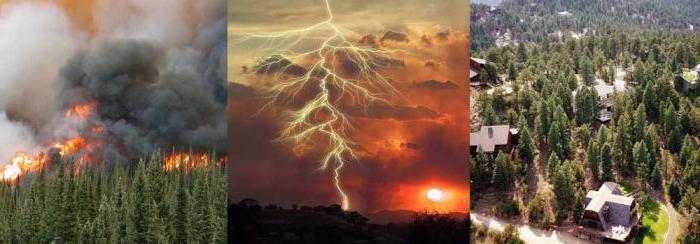
Another cause of forest fires is people. In some situations, fire occurs from deliberate actions aimed at destroying weeds. In addition, in the spring and summer, people go to barbecue or pick mushrooms. In this case, one unextinguished cigarette or firebrand is enough. As a result of such negligence, dry grass instantly ignites, and the flames very quickly spread to dry wood.
Classification of forest disasters
Based on the nature of the fire, soil, ground and crown fires are distinguished. Next, natural disasters are classified according to their speed of spread. Based on this, ground fire is divided into the following categories:
- Weak. A fire up to 0.5 m high covers 1 meter of territory in just a minute.
- Medium (height up to 1.5 m). Spreads at speeds up to 3 m/min.
- Strong (more than 1.5 m). Covers 3 meters in less than 3 minutes.
In turn, the speed of a crown fire is:
- Up to 3 m/min. This speed is considered weak.
- From 3 to 100 m/min. In this case, we talk about the average speed of propagation.
- More than 100 m/min. - strong fire.
From this it can be seen that a stable crown fire spreads at a speed of more than 100 meters in one minute. Accordingly, its scale is simply impossible to imagine.
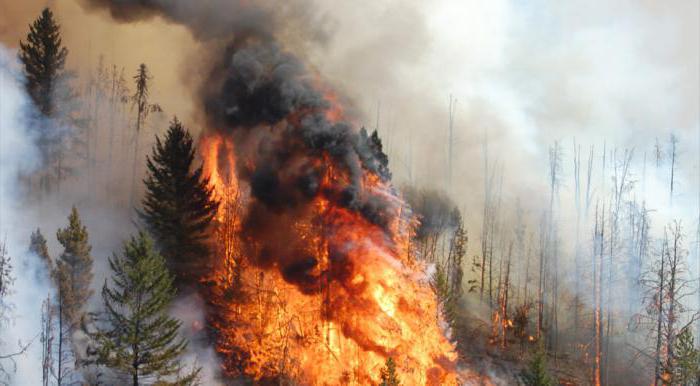
There is also a soil fire, which also spreads quite quickly. In this case, the burnout depth is taken into account:
- Less than 25 cm is a weak fire.
- From 25 to 50 cm - average.
- More than 50 cm - belongs to the category of strong.
In addition, the fire is classified according to the area of the fire:
- From 0.1 to 2 hectares is typical for a normal fire.
- Up to 20 hectares indicates low fire.
- 20-200 Ha is an average fire.
- Up to 2000 hectares is typical for a major disaster.
- Over 2000 hectares is already a disaster.
If we talk about the duration of the disaster, then during crown fires the area burns for about 10-15 days (depending on the level of fire). During this time, more than 500 hectares can burn out. Let's take a closer look at each type of fire.
Horse forest fire
Every fire is extremely dangerous for wildlife, animals, birds and, of course, for humans. Very often the flame reaches small settlements located near the forest. As a result, the fire quickly engulfs houses. Therefore, if an unusual haze appears in the sky, or there is a burning smell, you must immediately contact the Ministry of Emergency Situations.
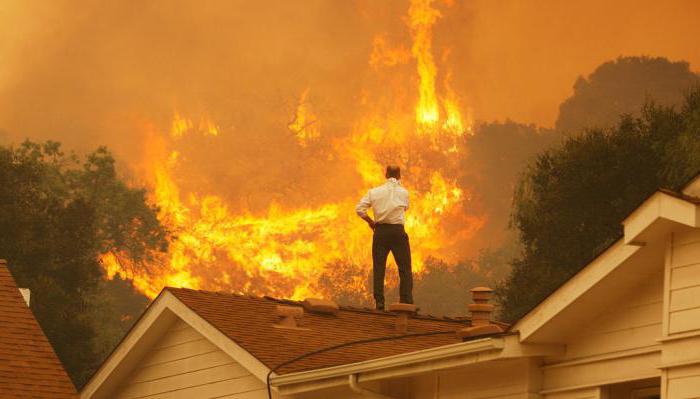
A crown fire affects the forest canopy. Most often, this type of fire results from the development of a low flame. Thus, we can say that a ground fire is a component of a top fire.
The occurrence of fire that is located above the soil surface is facilitated by natural factors. For example, strong wind And steep slopes can cause a crown fire to quickly spread. Most often, such fires occur in the summer, when dry and hot weather prevails.
In this type of fire, trees usually die completely. If we talk about the nature of combustion, then a fluent and stable crown fire is distinguished. The latter type is characterized by the fact that the crown of the tree burns out gradually as the ground fire develops. In this case, the flame does not move along the canopy. Such fires are also often called general fires. If we talk about a runaway fire, then in this case the fire, on the contrary, spreads along the canopy and can even outstrip the movement of the ground fire. Also in this case, flame jumps are observed, at the moment of which the fire can affect areas with greater speed.
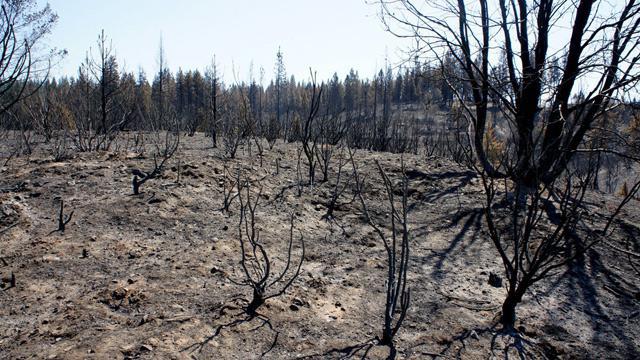
As mentioned earlier, top and bottom fires are practically one whole. Therefore, it is worth saying a few words about the second type.
Ignition in the lower tiers
In a ground fire, the fire moves along the underlying layer. The grass, undergrowth, and undergrowth are the first to catch fire. A ground fire usually moves in a semicircle, forming a contour of the main flame on the ground. The result is an edge.
![]()
If we talk about the nature of fires, then ground burning can also be fugitive or stable. In the first case, the edge of the fire moves very quickly at a speed of more than 0.5 m/min. As a result, only the soil cover burns out. If we are talking about a stable ground fire, then in this case the circuit speed is much lower. Accordingly, not only the underlying layer burns out, but also rotten stumps and dead wood. In this case, a strong formation of smoke is observed.
Soil ignition
Underground fires affect the root system of trees. They do not have a pronounced flame. A soil fire spreads deep into the ground and can move at speeds of up to 1 km per hour. Moreover, such fires are considered the most difficult, since they are very difficult to extinguish. A ground fire causes a ground fire, which in turn provokes the appearance of a top flame.
Extinguishing activities
A wide variety of equipment is used for firefighting: helicopters and airplanes. Thanks to the draining of liquid extinguishing compounds, the fire can be localized quite quickly. To determine the source of the fire, the area is screened.
However, in some cases, annealing (backfire) occurs. It burns fire extinguishing fluids before they even arrive. In this case, a shock wave is used. To do this, an explosion is carried out in front of the fire front, which initiates the appearance of a reflective screen. Thanks to this, it is possible to stop the further spread of the flame and extinguish it using standard methods.
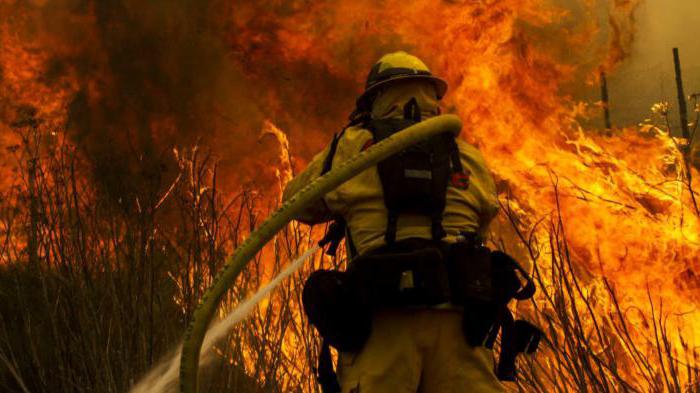
Preventive measures
First of all, experts try to predict the occurrence of fire in a particular area, based on weather conditions and data obtained from the area. In this case, the forest fire coefficient is calculated.
In order to reduce forest loss, a lot of organizational measures are being taken. First of all, fire prevention and preventive work is carried out. Sanitary logging is also carried out. In this case, all old and dried trees are destroyed. Forest belts that are dangerously close to populated areas are also being cut down. Special trenches are laid along the forest line, which in the event of a fire will not allow the fire to pass further.
In addition, forest fires are periodically monitored and special observation masts and towers are installed. Thanks to ground observation, it is often possible to prevent the occurrence of a natural tragedy.





